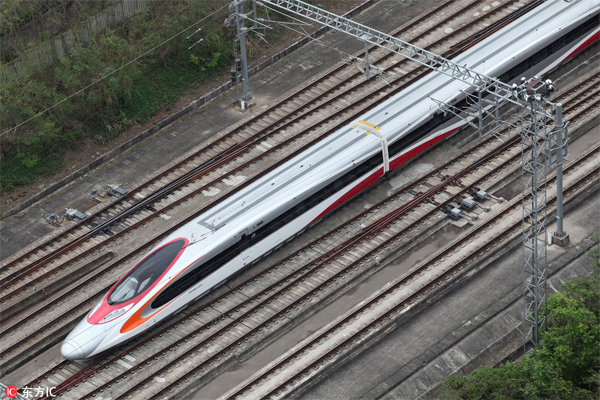Transport to play key role in Bay Area

A high-speed train runs on the Guangzhou-Shenzhen-Hong Kong Express Rail Link after departing from Shenzhen North Railway Station in Shenzhen, South China's Guangdong province, on May 11, 2018. [Photo/IC]
Transport was a priority when the Outline Development Plan for the Guangdong-Hong Kong-Macao Greater Bay Area was released in 2019, with the word appearing 29 times in its 60 pages.
A year later, the Bay Area, an urban cluster in South China's Pearl River Delta, received funding for 18 railroad projects spanning 775 kilometers.
With 474.1 billion yuan ($74 billion) approved by the National Development and Reform Commission, the Bay Area has laid a solid foundation for the mission of building a modern and comprehensive transportation system.
The Bay Area was officially mentioned for the first time in China's 13th Five-Year Plan in 2016. The 11 delta cities it comprises-nine in Guangdong province plus Hong Kong and Macao-were confirmed in the development outline three years later.
Covering only about 0.6 percent of China, the Bay Area, with over 72 million people, recorded a GDP of 11.5 trillion yuan last year, which made its economy larger than that of South Korea or the San Francisco Bay Area in the United States.
China expects the Guangdong-Hong Kong-Macao Greater Bay Area to unleash more potential by promoting and improving infrastructure connectivity between the cities. According to the plan, it will become a world-class bay area with innovation as its main support before 2035.The world-class standard targeted in transportation is to achieve a one-hour living circle in the Bay Area.
According to the timetable, half the projects, spanning a distance of 337 km, will be started before next year. The rest will be developed before 2035, when the Bay Area is expected to have a railway network of 5,700 km covering all its cities and counties.
It now has more than 1,200 km of high-speed railway line, with the journey between Guangzhou, Guangdong's provincial capital, and Hong Kong shortened to one hour in 2018 after the Guangzhou-Hong Kong High-speed Railway opened.
Given that some cities are on opposite sides of the Pearl River, which empties into the South China Sea, bridges are a vital factor in the successful completion of the one-hour living circle.
Before the plan was introduced, the Hong Kong-Zhuhai-Macao Bridge mega project was completed and put into use in 2018.
Consisting of three cable-stayed bridges, an undersea tunnel and four artificial islands, the bridge reduced travel times between Hong Kong, Macao and Zhuhai to just 30 minutes.
A similar approach is planned to overcome geographical constraints hindering travel between Zhongshan, on the west bank of the river, and Shenzhen, a vibrant special economic zone on the opposite bank, which currently necessitate a detour to the north.
Travel times between Shenzhen and Zhongshan will be reduced to 20 minutes after the Shenzhong Link is completed in 2024.
The 24-km link, being built at a cost of more than 44.69 billion yuan, comprises two suspension bridges, two artificial islands, and an underground interchange that will link an immersed tunnel with the bridges.
"The bridges stop at the interchange and vehicles will enter the 46-meter-wide immersed tunnel, the widest in the world, and arrive in Shenzhen on the east bank," said Chen Yue, deputy chief engineer of the link, adding that the design aims to provide enough space for the passage of ships along the river.
The building of a world-class airport cluster is also part of the plan.
Guangzhou's Baiyun International Airport was the world's busiest airport last year, welcoming over 42.7 million passengers. That saw it surpass Atlanta Airport in the US to become the world's No 1 airport in terms of passenger traffic.
Ma Xingrui, governor of Guangdong, said the construction of the airport cluster is moving forward with the ongoing expansion of Hong Kong International Airport, the third phase of Baiyun and construction of a third runway at Shenzhen Airport. "The annual capacity of all airports in the Bay Area exceeds 200 million now, which is more than any other bay area," he said.



 Print
Print Mail
Mail